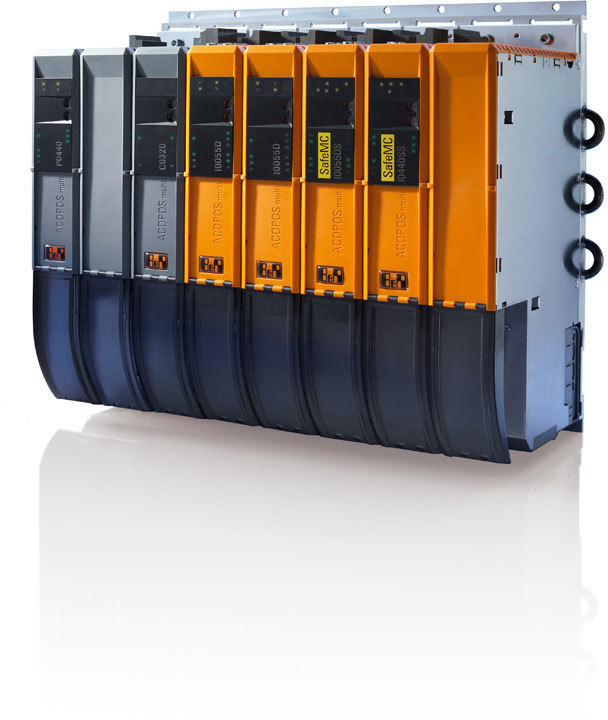
Sistema di azionamento modulare
La nuova generazione di azionamenti B&R fornisce una soluzione universale per qualsiasi task di automazione dedicato alla produzione di macchine. Una nuova pietra miliare sul cammino della "Perfection in Automation".
Moduli inverter (moduli ad asse singolo)
Moduli inverter, SafeMC (moduli ad asse singolo)
Moduli inverter (moduli a due assi)
Moduli inverter, SafeMC (moduli a due assi)
Moduli inverter ACOPOSmulti con SafeMC
Il sistema di sicurezza B&R esistente, costituito dai moduli X20 SafeIO, SafeLOGIC e dal toolset SafeDESIGNER di Automation Studio, è potenziato con l’aggiunta di unità a inverter ACOPOSmulti con Tecnologia di Sicurezza Integrata (SafeMC). Tutti i prodotti B&R con "Tecnologia di Sicurezza Integrata" sono ottimizzati per operare insieme. Ciò permette di realizzare soluzioni applicative di grande efficacia con tecnologia di sicurezza integrata e massimi risparmi sui cosi.
Ulteriori informazioni
openSAFETY definisce gli standard tecnici
Malgrado esistano numerosi nuovi approcci ai sistemi con bus di campo sicuri, la maggior parte di tali proposte si basa estensivamente su standard proprietari e presenta tempi di risposta lenti. Il sistema di sicurezza B&R è diverso e lo stesso vale di conseguenza per i moduli inverter ACOPOSmulti con SafeMC: in questo caso, l’approccio adottato si basa sull’impiego di openSAFETY a tutto campo. Questo sistema consente di attivare direttamente in rete le funzioni di sicurezza integrate come la limitazione di sicurezza della velocità (SLS). La cablatura degli azionamenti a questi tipi di segnali associati alla sicurezza è ormai un ricordo del passato.
Le informazioni vengono acquisite dalle rispettive fonti attraverso ingressi e uscite digitali sicuri, quindi vengono distribuite ai rispettivi sensori e attuatori, in questo caso gli azionamenti con funzioni di sicurezza integrate, tramite una CPU sicura: il controllore SafeLOGIC. Il collegamento tramite POWERLINK garantisce le migliori comunicazioni possibili fra i controllori SafeLOGIC e quelli standard utilizzati per la creazione dei programmi non associati alla sicurezza.
Tempi di ciclo veloci
Sulle unità a inverter ACOPOSmulti con SafeMC si raggiungono tempi di ciclo di 800 µs, mantenendo al tempo stesso il livello di sicurezza SIL3.
Sistemi modulari espandibili
Non tutti gli azionamenti e gli assi di una macchina di produzione coinvolgono aspetti di sicurezza. I moduli inverter ACOPOSmulti sono pertanto disponibili sia con, sia senza funzioni per la sicurezza integrata (SafeMC). Questo consente di combinare nelle applicazioni assi di sicurezza e non, secondo necessità.
Safety functions
The following safety functions are integrated in the drive in accordance with IEC 61800-5-2 thanks to ACOPOSmulti inverter modules with SafeMC and by embedding this component in the B&R Safety system. Additionally, "Safe speed" is also provided for the SafeLOGIC. This means that safety functions can be combined in an application as needed.
Safe state
In safety-related systems, potentially dangerous situations are not permitted, even when an error occurs. This is ensured by the two-channel hardware and firmware structure as well as by the system architecture.
Bias current fail-safe is applied in this situation. In the event of error, torque and power are always switched off on the drive.
Safe speed
If an EnDat 2.2 safety encoder is installed in a system, then the SafeLOGIC can request the current speed of the motor encoder via the secure network and use that information as input signal in a safe application. With an EnDat 2.2 safety encoder, the signal fulfills SIL2 in accordance with EN 61508.
Encoders
EnDat 2.2 safety encoders are used to safely determine and evaluate the position and speed of the motor. They determine the position redundantly, thereby achieving SIL2. The following safety functions are only available when using EnDat 2.2. safety encoders!
Configurazioni di ACOPOSmulti
ACOPOSmulti drive systems include multiple technology-specific functions. The ACOPOSmulti functions listed below are basic functions that the user can switch between as needed within 400 μs. In addition, manipulations such as changes in product length, registration mark control, overlying torque control, brief process adaptations and quality checks can be carried out at any time.
- Point-to-point movements
- Electronic gears
- Electronic differential gears
- Cutting units
- Electronic cam profiles
- Flying saws
- Line shafts
- CNC
ACOPOSmulti servo drives can be used in various configurations depending on the requirements of the application. The functions listed above are available to the user in each of the topology examples shown.
Response times are not influenced by the network and control system being used if technology functions are processed directly on the ACOPOSmulti drive system. Additional sensors and actuators must be integrated in the control system for more complex processes. In these cases, the level of performance depends mostly on the control system being used.
The topology examples shown on the following pages provide an overview of some of the options that are possible with B&R automation components.
ACOPOSmulti drive systems in a POWERLINK network
High-performance machine architectures require flexible networks and fieldbuses. With POWERLINK, a network is available to the user that fully meets the high demands of dynamic motion systems. POWERLINK adapts to the requirements of the machine and the system. The rigid coupling of many axes with controllers, industrial PCs, I/O systems and operator panels allows machines and systems to be created with the highest level of precision. Compatibility to standard Ethernet also reduces the number of networks and fieldbuses at the machine level.
Successful areas of use for these topologies
- Packaging industry
- Handling technology
- Plastics processing
- Paper and printing
- Textile industry
- Wood industry
- Metalworking industry
- Semiconductor industry